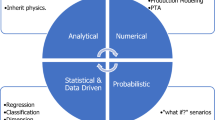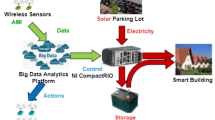Abstract
The operational flexibility requirement has brought great challenges to control systems of thermal power plants. Through the big data and deep-learning technology, intelligent thermal power plant can greatly improve the quality of deep peak-load regulation. Based on the framework of an intelligent thermal power plant, this paper proposes a control optimization framework by constructing a hybrid deep-learning simulation model adaptable for multiple disturbances and wide operational range. First, Gaussian naive Bayes is utilized to classify data for identification, in conjunction with prediction error method for fine data extraction. Second, deep long-short term memory is explored to fully learn extracted data attributes and identify the dynamic model. Third, based on the simulation model, two aspects are considered for control optimization: i) For a variety of immeasurable disturbances in thermal processes, the extended state observer is employed for disturbance rejection, and ii) as a widely used heuristic algorithm, particle swarm optimization is applied to optimize the parameters of controllers. Superheated steam temperature (SST) control system is the key system to maintain the safety and efficiency of a power plant; thus the proposed deep learning modeling and control optimization method is applied on the SST system of a 330 MW power plant in Nanjing, China. Simulation results compared with actual data and the index analysis demonstrated the effectiveness and superiority of the proposed method.
Similar content being viewed by others
References
R. F Nielsen, N. Nazemzadehm, L. W. Sillesen, M. Andersson, K. Gernaey and S. S. Mansouri, Comput. Chem. Eng., 140, 106916 (2020).
A. M. Najar and D. K. Arif, J. Phys.: Conference Series, 1218, 012055 (2019).
C. Fang and D. Xiao, Process identification, Tsinghua University Press, Beijing (1988).
S. Zheng and J. Zhao, Comput. Chem. Eng., 135, 106755 (2020).
Y. Guo, N. Wang, Z. Xu and K. Wu, Mechanical Syst. Signal Process., 142, 106630 (2020).
Q. Zheng, Y. F. Li and J. Cao, Comput. Commun., 163, 84 (2020).
Y. Zhang and J. Sun, 2nd International conference on electrical, computer engineering and electronics, 996–1001 (2015).
C. Chen, G. Zhang, R. Tarefder, J. Ma, H. Wei and H. Guan, Accident Anal. Prevention, 80, 76 (2015).
J. Feng, X. He and P. Wang, Comput. Digital Eng., 45, 2244 (2017).
Y. Nuo, Int. J. Appl. Dec. Sci., 11, 1 (2018).
T. Adedipe, M. Shafiee and E. Zio, Reliability Eng. Syst. Saf., 202, 107053 (2020).
O. O. Marlis, L. C. Agustin, V. Giancarlo, G. Rainer and V. S. Mitchell, NeuroImage, 163, 471 (2017).
M. R. Abdalmoaty and H. Hjalmarsson, Automatica, 105, 49 (2019).
I. Maruta and T. Sugie, IFAC-PapersOnLine, 51, 479 (2018).
W. Yu, I. Y. Kim, and C. Mechefske, Mechanical Syst. Signal Process., 149, 107322 (2021).
G. Rao, W. Huang, Z. Feng, and Q. Cong, Neurocomputing, 308, 49 (2018).
M. Rahman, D. Islam, R. J. Mukti, and I. Saha, Computational Biol. Chem., 88, 107329 (2020).
Z. Zhang, Z. Lv, C. Gan and Q. Zhu, Neurocomputing, 410, 304 (2020).
H. R. Yan, Y. Qin, S. Xiang and H. Chen, Measurement, 165, 108205 (2020).
Y. Chen, Optik, 220, 164869 (2020).
H. Fan, Z. Su, P. Wang and K. Y. Lee, Appl. Therm. Eng., 170, 114912 (2020).
H. Fu, L. Pan, Y. Xue, L. Sun, D. Li, K. Y. Lee, Z. Wu, T. He and S. Zheng, IFAC-PapersOnLine, 50, 3227 (2017).
J. Zhang, F. Zhang, M. Ren, G. Hou and F. Fang, ISA Trans., 51, 778 (2012).
F. L. Xiao, J. H. Zhang, D. Y. Zhu and C. Zhang, IFAC Proceedings Volumes, 34, 505 (2001).
T. Nahlovsky, Procedia Eng., 100, 1547 (2015).
C. Chen, L. Pan, S. Liu, L. Sun and K. Y. Lee, Sustainability, 10, 4824 (2018).
J. Hui, S. Ge, J. Ling and J. Yuan, Annals Nuclear Energy, 143, 107417 (2020).
C. Chen, K. Zhang, K. Yuan and W Wang, IFAC-PapersOnLine, 50, 4388 (2017).
F. Zhang, X. Wu and J. Shen, Appl. Therm. Eng., 118, 90 (2017).
G. Yuan and W. Yang, Energy, 183, 926 (2019).
H. P. Jagtap, A. K. Bewoor, R. Kumar, M. H. Ahmadi and L. Chen, Reliability Eng. Syst. Saf., 204, 107130 (2020).
H. M. Pesaran, M. Nazari-Heris, B. Mohammadi-Ivatloo and H. Seyedi, Energy, 209, 118218 (2020).
H. Xi, P. Liao and X. Wu, Appl. Therm. Eng., 184, 116287 (2021).
W. Song, C. Cattani and C. H. Chi, Energy, 194, 116847 (2020).
A. Gelman, B. Goodrich, J. Gabry and A. Vehtari, The American Statistician, 73, 307 (2019).
L. Sun, D. Li, K. Hu, K. Y. Lee and F. Pan, Ind. Eng. Chem. Res., 55, 6686 (2016).
K. J. Åström and T. Hägglund, Advanced PID control, International society of automation, Pittsburgh (2006).
D. Tang, Z. Gao and X. Zhang, Control Theory & Applications, 34, 101 (2017).
Q. Xu, M. Sun, Z. Chen and D. Zhang, In Proceedings of the 32nd Chinese Control Conference, 5408 (2013).
O. Hard, J. Appl. Statistics, 36, 1109 (2009).
Acknowledgements
This work was supported by the National Natural Science Foundation of China under Grants 51576040 and 51936003. The authors would like to give our sincere appreciation to the editor and anonymous referees for their careful review and valuable suggestions.
Author information
Authors and Affiliations
Contributions
Qianchao Wang: Methodology, Software, Validation, Data curation, Writing - original draft, Visualization. Lei Pan: Methodology, Formal analysis, Investigation, Resources, Writing — original draft, Supervision, Project administration. Kwang Y. Lee: Resources, Writing, Analysis. Zizhan Wu: Programming, Writing.
Corresponding author
Additional information
Conflicts of Interest
The authors declare no conflict of interest.
Rights and permissions
About this article
Cite this article
Wang, Q., Pan, L., Lee, K.Y. et al. Deep-learning modeling and control optimization framework for intelligent thermal power plants: A practice on superheated steam temperature. Korean J. Chem. Eng. 38, 1983–2002 (2021). https://doi.org/10.1007/s11814-021-0865-6
Received:
Revised:
Accepted:
Published:
Issue Date:
DOI: https://doi.org/10.1007/s11814-021-0865-6




